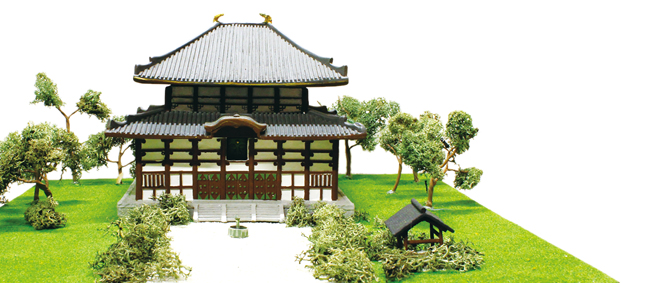
当たり前に日本人として生きてきた。でも海外に出てから、日本について何も知らないことに気が付いた。そこで、日本が世界に誇る世界遺産について建立年順に勉強しようと思う。興味がある人も、そうでない人も、しばしお付き合いを。
I’ve lived my whole life as a Japanese person, but when I went overseas I realised I know practically nothing about Japan. So now I’m learning about Japan’s World Heritage Sites, from oldest to newest. Those who are interested, and even those who are not, come along for the ride.

撮影協力 / メルボルン総領事館 Thanks to the Consulate-General of Japan, Melbourne
○○○○○ 東大寺 平和な世を願い気宇壮大な国家事業で建てられた寺院 ○○○○○
1998年に世界文化遺産に登録された古都奈良の文化財を、数回にわたり紹介してきました。今回はその中から、東大寺(とうだいじ)を紹介します。東大寺は、華厳宗(けごんしゅう)大本山の寺院で、正式名称は、金光明四天王護国之寺(きんこうみょうしてんのうごこくのてら)といいます。奈良時代、特に天平文化が花開いた時期は、正倉院宝物(しょうそういんほうもつ)に代表されるように華やかな時代でしたが、政治的な争いや、干ばつ・飢饉、凶作、地震、天然痘(てんねんとう)の大流行など、とても苦しく不安定な時代でもありました。そこで聖武天皇は、大乗仏教の根本経典といわれる『華厳経(けごんきょう)』を政治の中心にすえ、人々の心が思いやりの精神で繋がることができるよう、さまざまな政策を行いました。そのうちのひとつが、東大寺の建立でした。
そして東大寺といえば、なんといっても大仏。もしかしたら寺そのものより認知度が高いのでは? 大仏の正式名称は、『盧舎那仏(るしゃなぶつ)』といい、世界を照らす仏・ひかり輝く仏の意味だそうです。『華厳経』には、釈迦(しゃか)の身長を10倍することによって、無限大の宇宙を表現することが説かれていて、この大仏は宇宙を表しているそうです。スケールの大きな話ですよね。もちん大仏と呼ばれるだけあって実質的なスケールも大きい。高さは、像高14.98mで、像の下にある蓮華座高を入れると18.02mになります。745年に製作が始まり、完成したのは7年後の752年。当時、今のような重機がなかったことを考えると、かなり速いスピードで完成したのではないでしょうか。
個人的に、大仏の頭に付いている粒々に目が行ってしまうのですが、皆さんはどうでしょうか? あの粒状の物は『螺髪(らほつ)』と呼ばれるもので、髪の毛を表しているそうです。ひとつの螺髪の重さは約1.2kg。それが、966個付いているので、髪の毛だけで1,159.2kgもあることに! そんな大仏ですが、度重なる戦や天災などで破損・焼失し、何度も修復されてきました。現在、奈良時代から伝わっている部分は、台座、ひざ頭の一部のみとなっています。
大仏が鎮座する大仏殿は、創建から2度焼失し、鎌倉と江戸時代に再建されました。、江戸時代の再建の際に柱の木材が調達できず、創建時86mあった間口が、57mになってしまいました。それでも、世界最大の木造建築となっています。そういえば、柱のひとつに大仏の鼻の穴と同じ大きさの穴が開いていて、そこを通り抜けると頭が良くなると修学旅行で聞いた記憶が…。真相はいかに。
広大な敷地を誇る東大寺には大仏関連以外にも、東大寺建築のなかで最も古い法華堂(ほっけどう)、誰も見ることを許されていない絶対秘仏が収められている二月堂(にがつどう)、日本初の正式な授戒(じゅかい)の場である戒壇堂(かいだんどう)、日本最大の山門である南大門(なんだいもん)、天平時代の東大寺の伽藍建築をうかがわせる転害門(てんがいもん)などがあります。法華堂と転害門は、どちらも鎌倉時代の修理で改変されていますが、戦火や天災を逃れた奈良時代の建築物です。このように多くの国宝建造物があり、現在も年中行事などを通して人々の信仰の場として息づいていることから、世界遺産として登録されました。
次回は、古都京都の文化財のひとつである清水寺を紹介します。
○○○Todai-ji: a temple built to pray for peace on earth○○○
For many, Todai-ji brings to mind the Daibutsu (Giant Buddha), which may even be more famous than the temple itself! Its proper name is ‘Rushana-butsu’, meaning ‘the shining Buddha’. In the Avatamsaka Sutra the infinity of the cosmos is explained, and the giant Buddha statue at Todai-ji represents the cosmos itself. As you might guess from the name, the Daibutsu is enormous. The statue is 14.98m high, and 18.02m if you include the lotus it sits on. Construction began in the year 745, and was completed seven years later in 752. That’s pretty fast, if you consider that they didn’t have the sort of heavy machinery we do nowadays.
When I look at this Daibutsu my eye is drawn to the little balls covering his head. Known as ‘rahotsu’, they are supposed to represent curls of hair. Each curl weighs 1.2kg – and there are 966 of them, which would make the just the statue’s hair 1159kg in total! This Daibutsu has been repaired many times due to damage from war, fire, and natural disasters. Of today’s statue, it is thought that only the pedestal and knees are originals.
The great hall containing the Daibutsu burnt down and has been rebuilt twice, once in the Kamakura period and once in the Edo period. On the latter occasion, suitable wood for the pillars couldn’t be found so sadly the frontage was reduced from its original 86m to 57m. Despite this, it remains the world’s largest wooden building. That reminds me, I recall hearing while on a school trip that in one of the pillars is a hole the same size as the Daibutsu’s nostril, and if you pass through it you’ll get smarter... which may or may not be true.
Todai-ji’s grounds are extensive, including many more things apart from the Daibutsu: Hokke-do, the oldest structure of Todai-ji; Nigatsu-do, enshrining Buddha statues forbidden from public view; Kaidan-do, the location of the first official Buddhist ordination in Japan; Nandaimon, the largest temple gate in Japan; and Tengaimon, a good example of Tenpyo period temple architecture. Hokke-do and Tengaimon were both altered when repaired in the Kamakura period, but are original Nara period structures that escaped damage from wars and natural disasters. It is because of the many national treasures on the site and because it is still used today as a place of faith and religious events throughout the year that Todai-ji become World Heritage listed.
Next time we introduce one of the ‘Historic Monuments of Ancient Kyoto’: a temple called Kiyomizu-dera.

